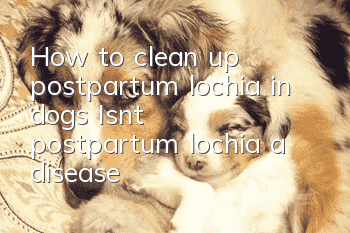How to clean up postpartum lochia in dogs? Isn’t postpartum lochia a disease?

Lochia after delivery in dogs
After the mother gives birth, the uterine decidua, especially the decidua at the placental attachment, is shed, containing blood, necrotic decidua and other tissue. Vaginal discharge is called lochia. Under normal circumstances, the dog's lochia will be eliminated within 5 days, and it will be delayed for another 1-2 days at most. If it continues to drip beyond this time, it is "inexhaustible lochia", which is called a certificate by Chinese veterinarians. This is also one of the common diseases among dog mothers after giving birth. The lochia of a dog mother is dark red and can turn into blood-like secretion within 12 hours after giving birth, and the amount increases.
[Symptom Category]
Lochia lasts about a week after the dog gives birth. In the early stage, the lochia contains blood and is red; in the middle stage, it turns to light yellow; in the later stage, it is transparent and clear. color, and then stops discharging. If it cannot be cleared for a long time or there is an abnormal stench, it indicates that there are pathological changes in the uterus.
Lochia in dogs after childbirthCauses
The postpartum stage of dogs includes the discharge of placenta, discharge of Lochia and the recovery of reproductive organs. process. The main changes in the postpartum canine reproductive tract are uterine mucosal regeneration, alternating exfoliation of maternal-fetal and placental mucosa, neoepithelial hyperplasia of uterine gland epithelium, "substantial atrophy" absorption of mucosa, and Lochia excretion.
The formation of lochia is mainly caused by the degenerated and shed maternal placenta, blood in the fetal membrane blood vessels, residual fetal fluid in the uterus, and large amounts of secretions from the uterine glands. In the first few days, lochia contains blood, so it will appear red; later it will gradually turn into a light yellow transparent liquid; and finally it will become transparent and stop being discharged.
Bacteria do not exist in lochia at first, but non-pathogenic bacteria may enter later, so they are harmless to the mother dog. Postpartum body temperature generally does not increase or change significantly. If the mother is severely dehydrated, lacks calcium, or has a birth canal infection, her body temperature will rise significantly. Generally, lochia is eliminated within 5 days, and it may be delayed for another 1 to 2 days at most. If lochia exists for a long time and cannot be eliminated or there is an abnormal stench, it indicates that there are pathological changes in the uterus.
The principle of treatment is to promote uterine contraction and expulsion and prevent infection. Properly isolate the baby dog, use broad-spectrum antibiotics and oxytocin, and provide adequate nutrition to increase the dog's resistance.
[Unexplained reasons]
After the dog baby is delivered, the residual blood and turbid fluid left in the uterus is called "lochia". The main causes of postpartum lochia are weak uterine contractions, uterine fatigue, endocrine disorders, local inflammation or retained placenta.
How to care for dogs with insufficient lochia after delivery
1. Cleaning and care
In the few days after delivery, especially in the few days after delivery, the dog The physiological processes in the mother's body are being adjusted, and the reproductive organs are undergoing great changes. Dog mother’s resistance is reduced and she will give birthDamage to the tract mucosa may become a pathway for pathogens to invade. When breastfeeding, you usually lie on your side. The vulva stays close to the bedding for a longer time, so it is more likely to cause infection. Parents should regularly disinfect and clean the dog's mother's vulva and perineum. Lochia contains a large amount of blood and other substances that are easy for bacteria to grow, so it can cause ascending infection and must be wiped clean in time. Clinically, 0.1% potassium permanganate water is commonly used as a cleaning solution because it has strong oxidizing effect and is non-irritating.
2. Pay attention to lochia
Oxytocin can also be injected subcutaneously. Always pay attention to the color and discharge of lochia. Generally speaking, excretion is completed within 5 days. Dog moms who had a dystocia or a C-section may have a little longer labor and more blood and a darker red color. If the discharge time is long, the color and smell are abnormal, and flocculent foam is found, it should be dealt with in time.
Notes
If the dog has lochia and the vaginal bleeding continues, postpartum fasting or Houttuynia cordata injection is required to promote uterine contraction. Going to the hospital is just like this, maybe the name is different. You can eat motherwort and brown sugar water after giving birth, which can warm and protect the uterus and help the mother dog recover quickly.
- Is it better for Dogo dogs to have their ears erect or cropped? A case of Dogo dog’s ear erection surgery will tell you
- What do dogs eat to protect their stomach? It is important to protect their stomach and treat gastrointestinal diseases in dogs.
- How to tell if your dog is fat? Is your dog overweight?
- Will your dog catch a cold if you blow the air conditioner? What should you do if your dog catches a cold if you blow the air conditioner?
- What should you pay attention to when your dog drinks water? Don’t be careless when it comes to your dog’s drinking water.
- The dog's mouth bites and shakes. Why does the dog's mouth occasionally shake and bite?
- How to cut a dog's hair? Do you know how to cut a dog's hair correctly?
- Can dogs eat raw eggs? Why can’t dogs eat egg whites?
- Common Dog Problems in Summer How to Deal with Different Dog Problems
- How to keep dogs away from skin diseases. If you do this, will you see if your dog will still be infected with skin diseases?



